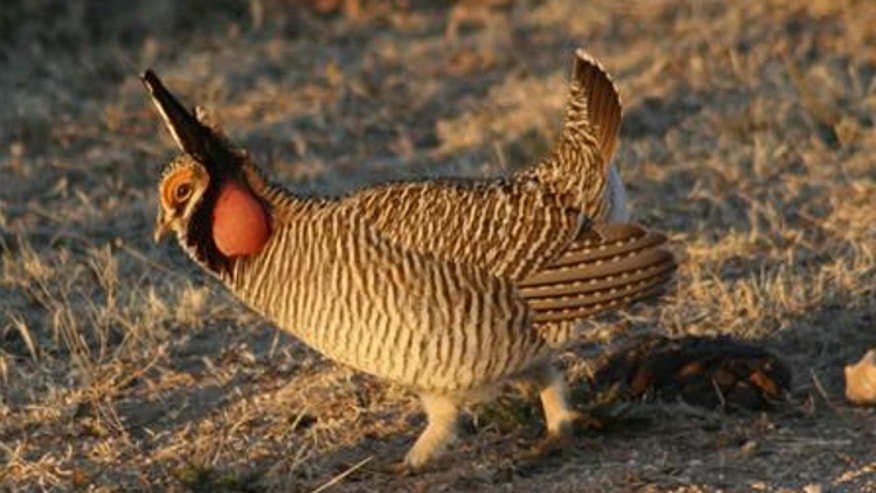Critics cry foul as feds place lesser prairie chicken on threatened species list

UNDATED: A lesser prairie-chicken is seen in this undated handout photo from the U.S. Fish and Wildlife Service.Reuters/USFWS
The Fish and Wildlife Service's decision, set to take effect around May 1, is a step below "endangered" status and allows for more flexibility in how protections for the bird will be carried out under the Endangered Species Act.
"This is an overreach on the part of the federal government," Brownback said in a statement. "We are looking at possible responses on this issue."
Asked whether that includes a lawsuit, Brownback spokeswoman Sara Belfry said: "That certainly is a possible response." Attorney General Derek Schmidt also said in a statement that his office is "assessing our legal options."
Fish and Wildlife Service Director Dan Ashe said he knows the decision will be unpopular with governors in the five affected states, but said the agency was following the best science available.
The prairie chicken, a type of grouse known for its colorful neck plume and stout build, has lost more than 80 percent of its traditional habitat, mostly because of human activity such as oil and gas drilling, ranching and construction of power lines and wind turbines, Ashe said. The bird, which weighs from 1-1/2 to 2 pounds, has also been severely impacted by the region's ongoing drought.
Biologists say a major problem is that prairie chickens fear tall structures, where predators such as hawks can perch and spot them. Wind turbines, electricity transmission towers and drilling rigs are generally the tallest objects on the plains.
Last year, the prairie chicken's population across the five states declined to fewer than 18,000 birds — nearly 50 percent lower than 2012 population estimates.
Oil companies have said potential new regulations would impede their operations and would cost them hundreds of millions of dollars in oil and gas development in one of the country's most prolific basins, the Permian Basin in Texas and New Mexico.
The listing decision, includes a special rule that Ashe said will allow officials and private landowners in the five affected states to manage conservation efforts. The rule specifies that activities such as oil and gas drilling and utility line maintenance that are covered under a five-state conservation plan adopted last year will be allowed to continue.
Oklahoma Gov. Mary Fallin, like Brownback a Republican, said she was disappointed, but added that she believes state and federal officials "have a unique opportunity to show how a plan based in state management of this species can allow for a quick recovery" and eventual de-listing of the bird.
Oklahoma's attorney general filed a lawsuit this month over the Obama administration's decision to settle a lawsuit with an environmental group over the listing status of the lesser prairie chicken and other species.
Attorney General Scott Pruitt claims in the lawsuit that federal agencies are colluding with like-minded special interest groups and using "sue and settle" tactics that encourage lawsuits that can be settled on terms favorable to the groups that filed them.
Ashe denied collusion with any group and said the agency hopes to avoid litigation over the listing decision.
Rep. Tim Huelskamp, R-Kan., said the Obama administration is threatening energy production and the property rights of farmers and ranchers. But he acknowledged that the federal government could have gone farther and listed the bird as endangered — with less flexibility in conservation measures.
"Nevertheless, an effective conservation effort must be strictly voluntary if private property is to be respected and our rural way of life to be protected," Huelskamp said in a statement.
Sen. Jerry Moran, another Kansas Republican, said the federal agency's decision will have "real consequences" for the economy but pledged to work with federal officials.
"I am confident there are ways to address conserving the species while not hampering economic growth and farming and ranching activities," Moran said in a statement.
In New Mexico, leaders of the state agriculture and energy departments and the interim director of the Game and Fish Department voiced their opposition in a statement, saying the listing will "without question decimate economic development and job creation in southeastern New Mexico."
The officials said they are considering all options for how to respond to what they call a "misguided decision."
The environmental group Defenders of Wildlife said the listing was "long overdue," but cautioned that the listing is weakened by "overly broad exemptions" for land uses that threaten the struggling populations of the lesser prairie chicken.
"We are talking about a species whose population has plummeted to half of its numbers in just one year," said Jamie Rappaport Clark, Defenders of Wildlife president. "This bird deserves effective federal protection, and the government recognized that over 15 years ago."
A consortium of oil and gas industry groups said the industry's effect on lesser prairie chickens is "poorly understood but likely to be negligible." Potential impacts can be mitigated through voluntary conservation plans, the group said in comments to the Fish and Wildlife Service before the ruling was announced.
"Adding another layer of regulation on the oil and gas industry in a region that is key to America's energy future and for which there is no clear environmental benefit runs counter to this administration's stated approach to energy and regulation," the group said. The 10-member group includes the American Petroleum Institute, the chief lobbying arm of the oil and gas industry, as well as America's Natural Gas Alliance, the Colorado Oil and Gas Association and the Independent Petroleum Association of America.
The Associated Press contributed to this report.
No comments:
Post a Comment